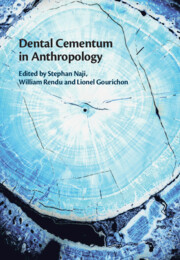Book contents
- Dental Cementum in Anthropology
- Dental Cementum in Anthropology
- Copyright page
- Dedication
- Contents
- Contributors
- Foreword
- Introduction: Cementochronology in Chronobiology
- Part I The Biology of Cementum
- Part II Protocols
- 9 Cementochronology for Archaeologists: Experiments and Testing for an Optimized Thin-Section Preparation Protocol
- 10 Optimizing Preparation Protocols and Microscopy for Cementochronology
- 11 Cementochronology Protocol for Selecting a Region of Interest in Zooarchaeology
- 12 Tooth Cementum Annulations Method for Determining Age at Death Using Modern Deciduous Human Teeth: Challenges and Lessons Learned
- 13 The Analysis of Tooth Cementum for the Histological Determination of Age and Season at Death on Teeth of US Active Duty Military Members
- 14 Preliminary Protocol to Identify Parturitions Lines in Acellular Cementum
- 15 Toward the Nondestructive Imaging of Cementum Annulations Using Synchrotron X-Ray Microtomography
- 16 Noninvasive 3D Methods for the Study of Dental Cementum
- Part III Applications
- Index
- Plate Section (PDF Only)
- References
16 - Noninvasive 3D Methods for the Study of Dental Cementum
from Part II - Protocols
Published online by Cambridge University Press: 20 January 2022
- Dental Cementum in Anthropology
- Dental Cementum in Anthropology
- Copyright page
- Dedication
- Contents
- Contributors
- Foreword
- Introduction: Cementochronology in Chronobiology
- Part I The Biology of Cementum
- Part II Protocols
- 9 Cementochronology for Archaeologists: Experiments and Testing for an Optimized Thin-Section Preparation Protocol
- 10 Optimizing Preparation Protocols and Microscopy for Cementochronology
- 11 Cementochronology Protocol for Selecting a Region of Interest in Zooarchaeology
- 12 Tooth Cementum Annulations Method for Determining Age at Death Using Modern Deciduous Human Teeth: Challenges and Lessons Learned
- 13 The Analysis of Tooth Cementum for the Histological Determination of Age and Season at Death on Teeth of US Active Duty Military Members
- 14 Preliminary Protocol to Identify Parturitions Lines in Acellular Cementum
- 15 Toward the Nondestructive Imaging of Cementum Annulations Using Synchrotron X-Ray Microtomography
- 16 Noninvasive 3D Methods for the Study of Dental Cementum
- Part III Applications
- Index
- Plate Section (PDF Only)
- References
Summary
Non-invasive 3D methods for imaging cementum increments using synchrotron radiation sources are one of the most promising new avenues for cementum research. This technique offers the opportunity to overcome the major caveats to traditional thin section imaging, and provides volumetric datasets of sub-micrometer resolution that can be investigated in new ways. Such studies can unlock the 3D structure of cementum increments, and 3D measures may allow for new inferences on the relationship between cementum growth and life history. However, as a new field of research, synchrotron X-ray imaging of cementum must ensure reproducibility by employing quantitative approaches to develop optimal experimental procedures and settings for imaging cementum in different samples. The quantitative parameter optimisation procedure we introduce in this chapter should form a crucial part of the imaging protocol that we present here, in which we outline the major steps in preparing for, performing and concluding a synchrotron imaging experiment, based on our own experience.
- Type
- Chapter
- Information
- Dental Cementum in Anthropology , pp. 258 - 272Publisher: Cambridge University PressPrint publication year: 2022



